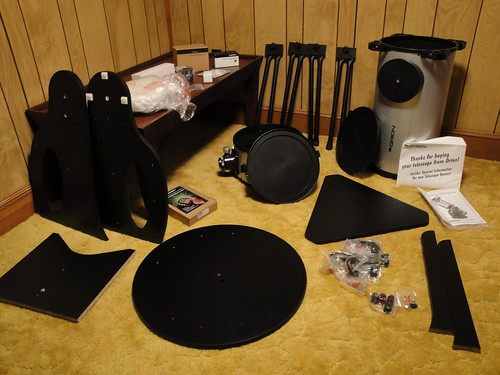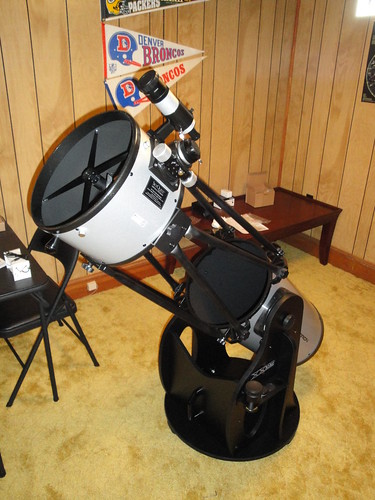Of course I’ll still have the telescope after this (this is a “lifetime telescope” after all) but I imagine this will be the last chapter in the “I finally get a telescope and must share every obsessive detail” part of the story.
So after Thursday’s initial test drive, Saturday was a chance to take another crack at a nice clear night, with as much prep and observing time as I wanted, complete with learning how to use the Intelliscope computer. Although it was clear, the moon was out and at first quarter, and very bright in the early evening when I’d be out, so I did have to contend with that. Just so you understand, the moon is awful pretty and all, but it is ungodly bright compared to everything around it and more or less washes out almost anything nearby that you want to look at with a telescope. I also had a good chance to play with the Starry Night software the telescope comes with. It’s a little clunky usability-wise but still pretty fun to play with. It’s easy to see what’s coming up in future weeks and months and years. I even fast-forwarded to August 21, 2017, and got a preview of the solar eclipse scheduled for that day.
Anyway, my primary goal was to get a shot at observing Jupiter, which is visible at the moment, but only just barely, as it can be seen very low in the southwest just after sunset. From my backyard, it was low enough to have trees as a problem, and the later I would be able to get outside to observe it the worse it would be. It will only start lower each night too, until the fall, when it will start rising at night again. So this was my last shot for a while. I got the telescope set up early, before sunset, and hung around with K trying to figure out how to time dinner while waiting for it to get dark enough. In the end I just barely got to see it. I did get a quick look, mostly like a sneak preview of things to come, but it was too low to really be an easy target and further, we ended up having some dinner-making hijinks that kept me preoccupied (the short version of the story is: recipes from Cook’s Illustrated are wonderful but insanely precise in their timing and required attention). Oh well. I’ll have a better chance in the fall when it rises again.
I got back out later on in the evening after it was fully dark and no food was burning on the stove, and had some quality time with the scope. K came out for a while too, and I got to show her some good things, but we were mostly thwarted by bright moonlight washing out some of the dimmer things to see. Plus there are no planets up right now so all in all it wasn’t a great night for showing off, so she went back into the warm house while I tinkered.
One goal, to learn to use the computer, was met. It’s actually a pretty clever little device and not at all hard to use once you get the hang of it. Biggest issue at this point is that simply sticking it to the base with velcro is not a great solution. The velcro comes off and the cord gets tangled. It’s certainly workable, but maybe a holster and a wireless link would be ideal (it just so happens they sell a holster – thanks, Orion, for not including the actual useful part in my $1300 purchase – but the wireless link is probably asking for a pretty huge step up that would probably just be overkill). It generally worked fine though in its primary mission, though, which was to tell me where stuff was. I’m not sold on its ID function thus far, though I’ll play with that more. The idea is that you can point at anything in the sky and it will identify it. I’m not sure it was working, and anyway it relies on the object being one of the things in its database. Considering there are millions and millions of things in the sky, but only thousands and thousands of things in the database, you’re going to have a lot of misses. One nice feature was the Tour: I took the February Tour, which hit on most of the highlights. It has a pre-programmed tour for each month where it cycles you through some interesting things to see. It focused on a few star clusters and nebulae, although the nebulae were generally not visible with the ambient light.
So at two observing nights completed, I’m happy with the scope. I’m learning (or re-learning) a lot about the sky and using a telescope and what it’s like to have access to a nice toy like this. I think I got a good scope for me overall – I could have saved some money, but I think I would have probably just been wishing I’d have gotten more had I gone with a smaller device. Unfortunately I have been spoiled by some very nice telescopes and observing opportunities in my life. But I think this will keep me happy. I traded some features like easy setup and a tracking motor for a larger mirror, but I think that’s really what I care about the most, so I am pleased. Mostly at this point, I *love* feeling in touch with what’s going on in the sky again: having a sense of what phase the moon is in, where planets are, what constellations are visible, and when all that will change, and having a good tool to witness it.
Last point of discussion: my backyard. Is this really going to work for most observing? With some qualifications, I say yes. Now, it’s not great. B-/C+ probably.
Good:
- It’s MY yard, and right outside my door, and near my kitchen where I have snacks. For a telescope as big as this one, convenient location wins.
- Best view is to the south, which is really where you want to be looking anyway.
- If I get the telescope in the right spot in the backyard, I have privacy and no visible streetlights (though they are around and do contribute to some light pollution, certainly–I just can’t see the bulbs).
Bad:
- Downtown is also to the south, so there’s a fair amount of ambient light low in the sky.
- Very limited view to the north or west, thanks to tall trees.
In short, I could be doing a lot worse for backyard observing, but I could also be doing a lot better, and once in a while I’m going to be forced to drive somewhere darker or with a more complete view of the sky.
Anyway, I’m excited for a lot of upcoming observing. Saturn will be visible in the early evening hours before too long, and this first year with the telescope should be a lot of fun as I get to plan to see all the major hits as they cycle through the sky during the year.

